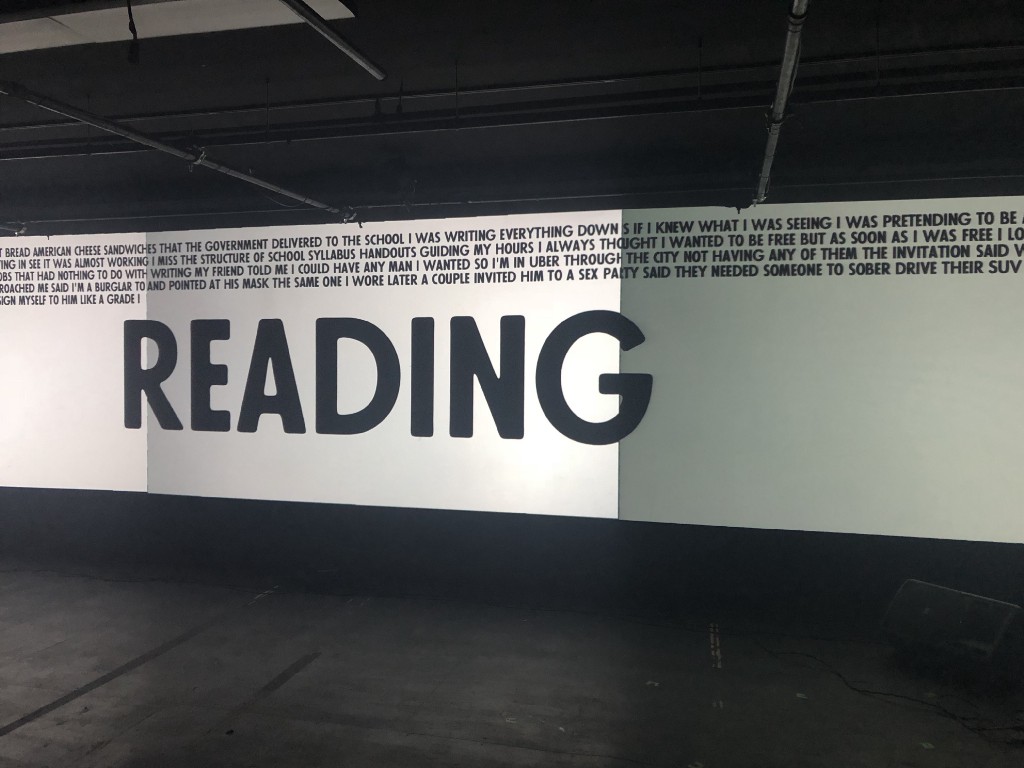Craft
Jeff VanderMeer on the Art and Science of Structuring a Novel
The author of “Annihilation” and “Wonderbook” shares some of the secrets of structure
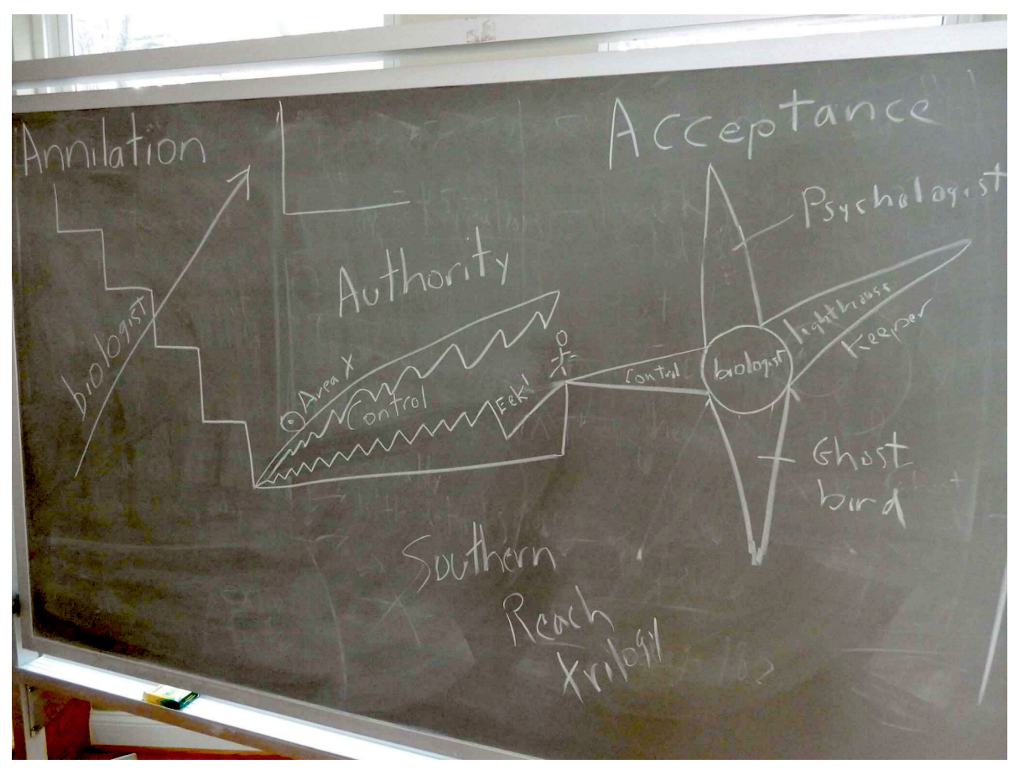
The following is adapted from a lecture given at Columbia University in April, 2018, and some of the images are reprinted from the author’s Wonderbook: The Illustrated Guide to Creating Imaginative Fiction. A revised and expanded edition of Wonderbook was published this month. Additional content can be found at the Wonderbooknow website. (Artist Jeremy Zerfoss created all diagrams reproduced here, unless otherwise noted.)
To learn, I love to be in conversation with interesting creators of all types, from many different narrative perspectives — and to also reflect this eclecticism in my reading. But I have learned the most from deep study of fiction itself: that which I have loved, that which I have hated, and that which has bored me. Boredom is not a neutral state and must be interrogated as thoroughly as any other reaction.
So, with that said, what I am going to present tonight is a series of thoughts on subjects that have been on my mind most urgently the past few years, which I find related for reasons that may or may not become apparent by the end.
As ever, I hope you find something of use, something you vehemently reject, something that bores you (why does it bore you?), and something you already knew before I made my remarks.
The first area I would like to address concerns structure — both in terms of the scaffolding I need as a writer to write a novel and how study of what is formally known as “structure” can allow a writer to access interesting options for storytelling in their own fiction.
This is generally a mechanical process in the beginning and, of necessity, an organic process in the end. Unless you do it wrong, which can itself be a feature not a bug. But the issue of structure is also an issue of not letting scaffolding or the idea of “architecture” stifle the text or remove a certain mystery from the text.
Structure should allow things to peer through and come free, not form a prison for the characters or the writer.
Structure should allow things to peer through and come free, not form a prison.
In part, this occurs naturally, if you think of structure as the musculature or skeleton of how the character moves through and expresses the story. A character creating a story and the residue or evidence of their passage, the structure. A kind of exoskeleton or cicada husk left behind.
This is another form of creating what your mind needs to write the story in your head in its purest form. Even as all stories lose some part of themselves in the transition from a liquid or metaphysical state in the mind to a physical or solid state in the world, a process that’s just part of the dissipation that is storytelling.

What do I mean by “a writer’s scaffolding”? I mean something in addition to what seem the basics of what I need to start writing after having first thought about a story for a long time. Those basics are pretty…basic. Knowing where the story starts; a character I’ve come to know well; a sense of where the character is going (either figuratively or literally); a charged image connected to the character; and an ending, even if that ending changes before I reach it. The charged image must be resonant and significant, but not one rendered dead or fixed by, for example, the prison of Freudian symbolism.
Without these elements in place, I’ve learned if I begin to write I will not finish a story or novel and I will likely be unable to backtrack and start over in a way that isn’t doomed to failure.
But, especially on novels, a kind of darkly glittering, revolving, usually architectural image also materializes in my mind that acts as a kind of compass — takes the form of some structure that speaks to theme and form, but is not the actual structure of the novel. It is instead a kind of scaffolding that I require and need to remember for the fiction to attain depth and originality. Thus, it is a kind of illogical creation, needing only to create a signpost for the subconscious, but in a way that has a dream-logic or perhaps novel-logic associated with it.
A kind of darkly glittering, revolving, usually architectural image materializes in my mind that acts as a kind of compass.
For example, on Acceptance, the third novel in the Southern Reach series, I imagined a four-pointed glowing star and at the center of that star, from which all else radiated outward, was the return of the biologist from the first book, Annihilation, and her further account of exploration.
From the rest of this account all else shines forth. The image likely occurred because of an intense study of different kinds of lighthouse lenses and different kinds of light emitted from lighthouses for specific kinds of communication or warning.
In my mind, this shining star revolved against a black background as I wrote the novel and at no time was it not present during that writing process. Yet it is in no way an accurate depiction of the novel’s actual structure. Even as it represents a kind of emotional and thematic structure, a resonance, in that the echo or ghost of the biologist could be said to permeate the other parts of the novel and, even if visible only to me on a literal level, and not to the reader, she is peering out from the blank spaces between the words in those (many) sections of the novel in which she is not physically present. Creating depth that the reader hopefully does experience, although they cannot see the light creating that depth.
If the structure here presented for Annihilation is cursory and more pragmatic, that is because I wrote the novel so quickly and almost without identifiable conscious impulse. I knew only that it was dangerously important that I must always think of the expedition in the novel as forever traveling DOWN even when proceeding physically across level ground or going up — and that this affected word choice, dialogue, and other elements as I wrote, some of which I later enhanced in revision and some of which I deleted as too obvious, but even in the deletion left behind a disorienting absence.
At the same time, however, I felt the biologist was always ascending, because, as the expedition disintegrates, she acclimates to the landscape they traverse.
In Authority, the main character all unknowing is already within the maw of a giant beast of sorts and the jaws are closing.
These constructs — this pseudo-structure or scaffolding, then — are completely organic for me and comes to me seemingly unbidden as a kind of hovering inspiration shining out over the more tactical inspirations that come over me at the scene, paragraph, and sentence level. I trust it despite its illogic because I’ve found the more I trust my subconscious and reward it, the more it rewards that trust with more ideas and characters.

Scaffolding aside, there is also the conscious examination of structure in novels — both at the macro level of the entire novel but also at the micro level of scene. Yet even study of what is formally recognized as structure has an element of uncertainty because there is variation in how different writers perceive words like “plot” and “structure.” It is significant that even in Madison Smartt Bell’s excellent Narrative Design, he clearly defines plot as opposed to structure or form and then seems to, at times, confuse or use the two terms interchangeably anyway.
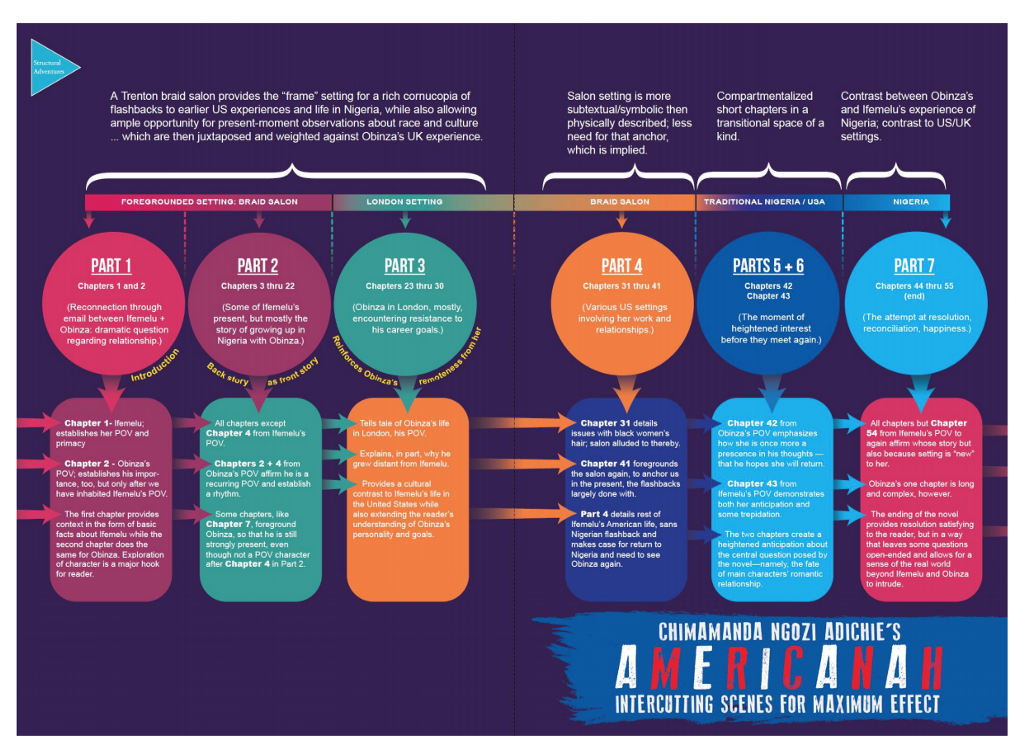
Some analysis of structure is more equal than others. For example, consider this diagram I made in studying Chimamanda Nogzi Adichie’s Americanah. The diagram breaks down the structure chapter by chapter and analyzes the effects created through use of two main points of view, going back in time in some scenes, and how it overcomes the potentially static quality of using one setting, a hair salon, for several scenes — incorporates the hair salon into the structure, in a way.
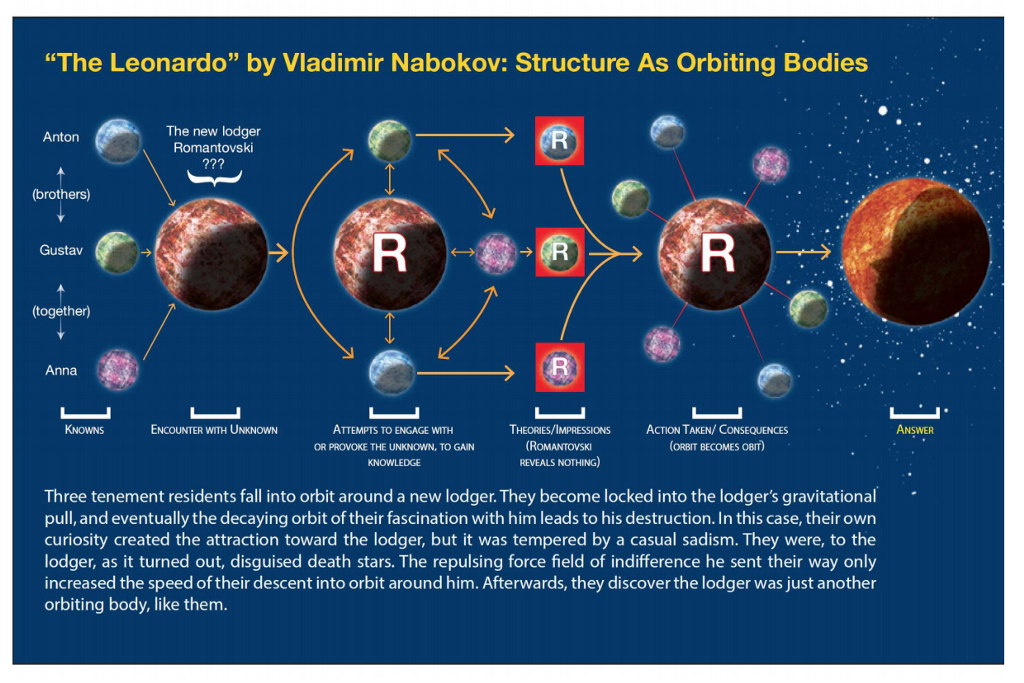
This diagram of Vladimir Nabokov’s story “The Leonardo” also shows a kind of structure, but in doing so I employed a metaphor — characters as planets orbiting another character-planet. This approach accurately conveys the effect of the story, but is not in any conventional sense the actual structure of the story.
This approach to analysis lies somewhere between the darkly glittering scaffolding I need for my own work and an objective view of someone else’s structural decisions. What is lost is a true seeing of the original writing of the story. What is gained is an idea about the use of characterization in the story — i.e., that in a sense the story elements are deployed in the service of showing what happens when three friends living in a tenement building encounter a fourth person, who is a stranger, and when in contact with this stranger the others basically have an allergic reaction and plot to destroy him, to drive out the other. In doing so, they themselves enter a decaying orbit as they are lessened and lose any sense of a moral compass in pursuit of their goal.
The point here is that analysis is often just one subjective view of the structure regarding a published work of fiction, with varying levels of quantifiable “objectivity.” The analysis inevitably reflects the point of view of the writing doing the analysis, based on their own view of fiction.
The best and most personal value to you, despite what you might (or might not) glean here…is to perform your own analysis of structure — of your favorite and least favorite works. And of the structures of the works I’ve diagrammed here. Because an instructor’s analysis will, to varying degrees, take the form of another kind of internalized, personal scaffolding.
This issue comes up in comparing the structure of Nigerian writer Amos Tutuola’s The Palm-Wine Drinkard (1959) and U.S. writer Ben Metcalf’s Against the Country (2015). I find myself wondering what is lost and gained even in the transition from this horizontal, chalk-scrawled version….
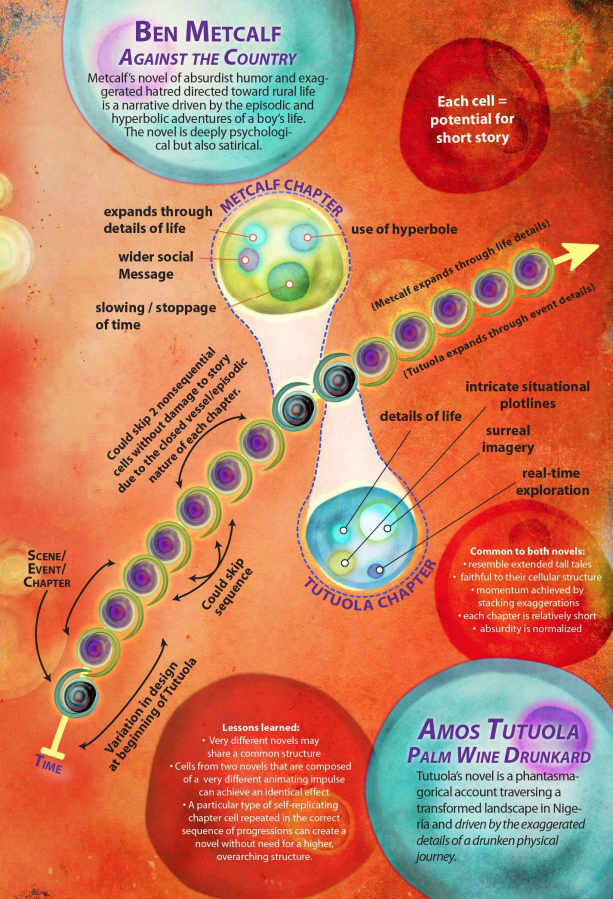
…and the final vertical version, which seems to compact the spine of the diagram.
Even as the main point remains: Just as the bones that comprise a killer whale’s flipper shock us with their similarities to a human hand, so too can we find unexpected kinship in the structures of what seem like vastly different novels. Metcalf’s novel and Tutuola’s are brethren in their deployment of the components of their structure or design.
Against the Country, haunted by the past, is the darkly hilarious tirade of a man against a childhood spent against his will in rural Virginia. The Palm-Wine Drinkard is the surreal account of a drunk man encountering actual phantoms, including “the complete gentleman,” a skull attempting to reconstitute his other parts (much like many fictions) and a monster that devours 4,000 babies and the narrator (for a time). Written in different eras by writers from vastly different backgrounds, they would seem to occupy spaces with no subset of similarities between them.
We can find unexpected kinship in the structures of what seem like vastly different novels.
Metcalf’s novel of absurdist humor and exaggerated hatred directed toward rural life is a narrative driven by the episodic and hyperbolic adventures of a boy’s life. The novel is deeply psychological but also satirical. Tutuola’s novel is a phantasmagorical account traversing a transformed landscape in Nigeria and driven by the surreal details of a drunken physical journey.
In fact, at the tactical level, they use the same units of measure, so to speak. The chapters, or cells, that comprise the two novels are surprisingly similar despite a very different animating impulse. A particular type of self-replicating chapter-cell occurs in both, one that short story writers wanting to write a novel for the first time should study closely.
Because in both novels, each relatively short chapter has the same structure, without a need to create a higher-overarching architecture to house or constrain the narrative other than what is stated at the beginning: Metcalf’s narrative will tell us about his childhood in Virginia; Tutuola’s narrative will tell us about a roving journey set across one night.
Both achieve momentum and maintain momentum by stacking exaggeration and hyperbole. Both avoid being simply a series of interlinked short stories by how, often just slightly, each chapter does build on the next by advancing the narrative while also featuring recurring characters of a sort. Absurdity is normalized so that tension can be retained in part by ever-greater absurdity that doesn’t seem ridiculous because we’ve already become accustomed to the prior level of absurdity. (The same principle applies to my novel Annihilation, but in terms of the uncanny impulse and stacking of tropes.)

But what lies at the opposite end from personal scaffolding (and equidistant from a more objective view of structure)? Perhaps this science of scenes diagram suggests one answer. The diagram attempts find the right level to extract useful generalities about structure — to express something that, admittedly, doesn’t apply to all fiction. It may fail in a sense to convey what it attempts to convey. Which is to say, what it wants to convey may not be communicable through a diagram. Nonetheless, I believe even ignoble failures can be more interesting and useful than staid successes.
Part of what led me to create this diagram is that I’ve become a little obsessed with how even a tiny change to where you start or end a scene can greatly affect how the reader perceives the scene and even how a reader or editor perceives the genre of the scene and thus the book as a whole. This thought suggests greater similarities between seemingly unalike pacing and styles, in that the actual difference is one of a missing cause to an affect or vice versa, to use a crude example. And once you can chart these similarities and differences at the right level of detail and hierarchy, you are much more able to control the effects of your fiction and even to shift modes within the same novel in ways that don’t seem jarring.
I do believe that with the right progressions — of a character’s emotions, of events in the story, to name only two types — anything is possible in fiction. I also believe that the idea of “beats” is often misunderstood as purely commercial consideration within screenplays. In fact, a serious, complex exploration of the way in which beats in a story support progressions or don’t support them can lead to serious break-throughs in a writer’s knowledge of the art and craft of writing. Showing these ideas in an almost cellular way helps to re-imagine them as organic, and thinking of them in abstract ways allows them to then be re-imbued in a flesh-and-blood sense on the page in a particular story or novel.

Where the diagram becomes impractical, perhaps, is that not all scenes have time intrusions because they lack that kind of character interiority. Contaminations of the scene can reflect a writer’s awareness of possible fatigue on the part of the reader rather than an actual condition that occurs across all kinds of scenes. However, by articulating these elements as if they are constant, it forces the reader of the diagram to construct their own version in opposition — in a sense, to correct the idea at the same level of abstraction. Perhaps this proves that even inaccurate writing diagrams can be of use to a writer.
As should be clear from this brief examination of structure, I believe in letting what should be organic in fiction express itself organically — and to proceed mechanically with what can be made mechanical and achieved through analysis and study without harm to the imagination. Without this second belief, I wouldn’t participate in workshops or give lectures about creative writing. Even as I eschew a distinction between “art” and “craft” in fiction because they aren’t terms in disagreement — the craft of writing fiction supports the art.
About the Author

Jeff VanderMeer is the author of the bestselling, critically acclaimed Borne and the Southern Reach Trilogy. His work has won the Shirley Jackson Award and been translated into 35 languages. His nonfiction appears in the New York Times, Los Angeles Times, and on the Atlantic’s website.





